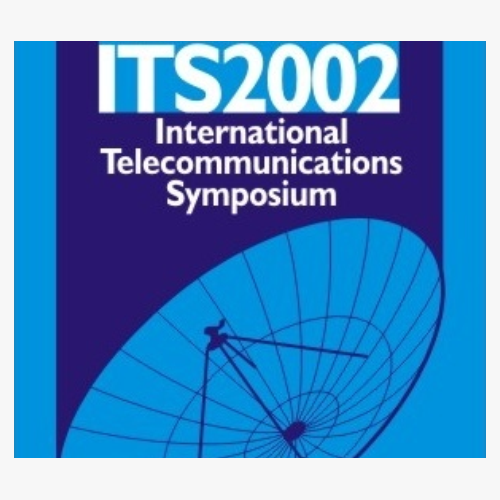
2002 International Telecommunications Symposium
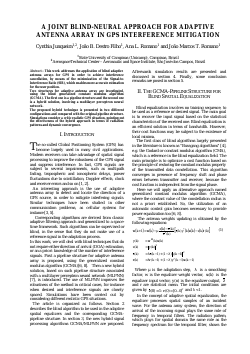
A Joint Blind-Neural Approach for Adaptive Antenna Array in GPS Interference Mitigation
Cynthia Junqueira, João B. Destro Filho, Ana L. Romano, João Marcos T. Romano
DOI: 10.14209/its.2002.377
Keywords:
Abstract
"This work addresses the application of blind adaptive antenna arrays for GPS in order to achieve interference cancellation, by means of the minimization of the Signal-to-Interference Ratio (SIR), which enables more accurate estimation for the user position. Two structures for adaptive antenna array are investigated, using the blind generalized constant modulus algorithm (GCMA). The first one is a pipeline structure and the second one is a hybrid solution, involving a multilayer perceptron neural network. The proposed hybrid technique is presented in two different configurations and compared with the original pipeline structure. Simulations consider a critic realistic GPS situation, pointing out the effectiveness of the hybrid approach in terms of radiation patterns and dynamic convergence."Download
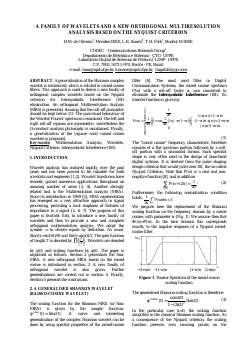
A Family of Wavelets and a New Orthogonal Multiresolution Analysis Based on the Nyquist Criterion
H.M. de Oliveira, L.R. Soares, T.H. Falk
DOI: 10.14209/its.2002.383
Keywords: Multiresolution Analysis Wavelets Nyquist Criterion Intersymbolic Interference (ISI).
Abstract
"A generalisation of the Shannon complex wavelet is introduced, which is related to raised cosine filters. This approach is used to derive a new family of orthogonal complex wavelets based on the Nyquist criterion for Intersymbolic Interference (ISI) elimination. An orthogonal Multiresolution Analysis (MRA) is presented, showing that the roll-off parameter should be kept below 1/3. The pass-band behaviour of the Wavelet Fourier spectrum is examined. The left and right roll-off regions are asymmetric; nevertheless the Q-constant analysis philosophy is maintained. Finally, a generalisation of the (square root) raised cosine wavelets is proposed."Download

Adaptive Channel Equalisation Using Minimum BER Gradient-Newton Algorithms
Rodrigo C. de Lamare, Raimundo Sampaio-Neto
DOI: 10.14209/its.2002.389
Keywords:
Abstract
"In this paper we investigate the use of adaptive minimum bit error rate (MBER) Gradient-Newton algorithms for channel equalisation applications. The proposed algorithms approximate the bit error rate (BER) from training data using linear transversal and decision feedback (DFE) equaliser structures. A comparative analysis of linear and DFE equalisers, employing minimum mean squared error (MMSE), previously reported MBER and the proposed MBER algorithms is carried out. Computer simulation experiments show that the MBER Gradient-Newton approaches outperform other analysed algorithms and can operate with shorter training sequences."Download
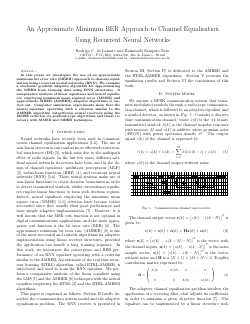
An Approximate Minimum BER Approach to Channel Equalisation Using Recurrent Neural Networks
Rodrigo C. de Lamare, Raimundo Sampaio-Neto
DOI: 10.14209/its.2002.395
Keywords:
Abstract
"In this paper we investigate the use of an approximate minimum bit error rate (MBER) approach to channel equalisation using recurrent neural networks (RNN). We examine a stochastic gradient adaptive algorithm for approximating the MBER from training data using RNN structures. A comparative analysis of linear equalisers and neural equalisers, employing minimum mean squared error (MMSE) and approximate MBER (AMBER) adaptive algorithms is carried out. Computer simulation experiments show that the neural equaliser operating with a criterion similar to the AMBER algorithm outperforms neural receivers using the MMSE criterion via gradient-type algorithms and linear receivers with MMSE and MBER techniques."Download
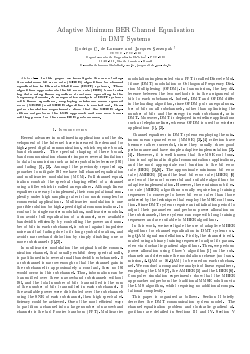
Adaptive Minimum BER Channel Equalisation in DMT Systems
Rodrigo C. de Lamare, Jacques Szczupak
DOI: 10.14209/its.2002.400
Keywords:
Abstract
"In this paper we investigate the use of adap- tive minimum bit error rate (MBER) algorithms for channel equalisation in Discrete Multitone (DMT) systems. These algorithms approximate the bit error rate (BER) from training data using linear equaliser structures operating in the frequency domain. A comparative analysis of DMT systems with linear equalisers, employing minimum mean squared error (MMSE) and MBER algorithms is carried out. Computer simulation experiments show that the MBER algorithms outperform the LMS approach and can save transmitting power for the same BER performance."Download
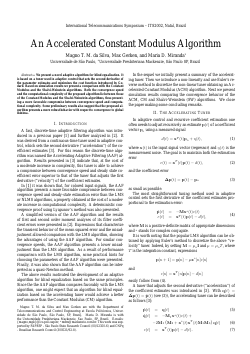
An Accelerated Constant Modulus Algorithm
Magno T. M. da Silva, Max Gerken, Maria D. Miranda
DOI: 10.14209/its.2002.405
Keywords:
Abstract
"We present a novel adaptive algorithm for blind equalization. It is based on a tuner used in adaptive control that sets the second derivative of the parameter estimates and minimizes the cost function introduced by Godard. Based on simulation results we present a comparison with the Constant Modulus and the Shalvi-Weinstein algorithms. Both the convergence speed and the computational complexity of the proposed algorithm lie between those of the Constant Modulus and the Shalvi-Weinstein algorithms, thus presenting a more favorable compromise between convergence speed and computational complexity. Some preliminary results also suggest that the proposed algorithm presents a more robust behavior with respect to convergence to global minima."Download
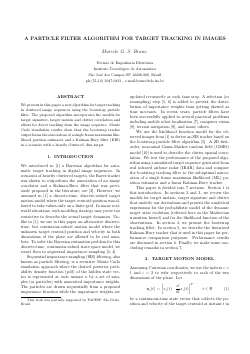
A Particle Filter Algorithm for Target Tracking in Images
Marcelo G. S. Bruno
DOI: 10.14209/its.2002.418
Keywords:
Abstract
"We present in this paper a new algorithm for target tracking in cluttered image sequences using the bootstrap particle filter. The proposed algorithm incorporates the models for target signature, target motion and clutter correlation and allows for direct tracking from the image sequence. Monte Carlo simulation results show that the bootstrap tracker outperforms the association of a single frame maximum likelihood position estimator and a Kalman-Bucy filter (KBf) in a scenario with a heavily cluttered, dim target."Download
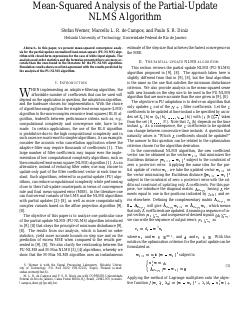
Mean-Squared Analysis of the Partial-Update NLMS Algorithm
Stefan Werner, Marcello L. R. de Campos, Paulo S. R. Diniz
DOI: 10.14209/its.2002.424
Keywords:
Abstract
"In this paper, we present mean-squared convergence analysis for the partial-update normalized least-mean square (PU-NLMS) algorithm with closed-form expressions for the case of white input signals. The analysis used order statistics and the formulas presented here are more accurate than the ones found in the literature for the PU-NLMS algorithm. Simulation results shows excellent agreement with the results predicted by the analysis of the PU-NLMS algorithm."Download

Subspace-based Estimation Methods Suitable for Downlink DS-CDMA Blind Detectors
Cassio G. G. Soares, Marcello L. R. de Campos
DOI: 10.14209/its.2002.430
Keywords:
Abstract
"In subspace-based blind linear multiuser detection we may use a subspace tracking algorithm and a blind method for estimating the composite code vector, which is the convolution of the user code and the multipath channel. In this paper we propose two subspace tracking algorithms based on the Power method, one with O(N^2 L) and the other with O(NL) operations per update (where N is the dimension of sampled received signal and L is the rank of the estimated subspace). We also propose a blind method for estimating the composite code vector, which uses the estimated signal suboperations per update (considspace bases. This method requires O(N^2 L) operations per update (considering that L is larger than the number of multipath gains). The proposed algorithms are suitable for subspace-based blind linear multiuser detectors for DS-CDMA system downlink. Computer simulations show superior performance of the methods proposed in comparison with other methods presented in the literature."Download
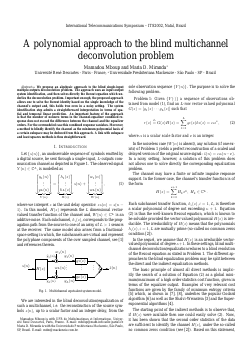
A polynomial approach to the blind multichannel deconvolution problem
Mamadou Mboup, Maria D. Miranda
DOI: 10.14209/its.2002.436
Keywords:
Abstract
"We propose an algebraic approach to the blind single-input multiple-outputs deconvolution problem. The approach uses an input-output system identification, and then solves directly the Bezout equation which underlies the deconvolution problem. Important enough, the proposed approach allows one to solve the Bezout identity based on the single knowledge of the channel’s output and, this holds true even in a noisy setting. The system identification step admits a straightforward interpretation in terms of spatial and temporal linear prediction. An important feature of the approach is that the number of nonzero terms in the channel-equalizer combined response does not exceed the difference between the channel and the equalizer orders. For the overmodeled case this combined response vanishes. Moreover, a method to blindly identify the channel as the minimum polynomial basis of a certain subspace may be deduced from this approach. A link with subspace and least squares methods is thus straightforward."Download